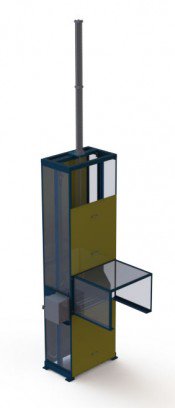
Anatomy of a Pneumatic Lift
Bastian Solutions | 28 April 2016
Pneumatic lift elevators can be an economical solution for transferring products between elevations in your material handling system.
Within a complex material handling system, product may need to be transferred between elevations. The most commonly used piece of equipment for this elevation transfer is an elevator lift. For light duty applications such as totes and boxes, a pneumatic lift elevator is a very economical solution.
A pneumatically actuated lift elevator is much less expensive when compared to other styles of lift elevators due to the minimal power transmission componentry required. Another key factor to consider for a lift elevator is the length of travel. For short travel distances, a pneumatic lift is very inexpensive. For longer distances (8 feet), an alternate style should be considered. This is partially due to the fact that the overall height of the elevator will be more than double the length of travel, and at that length, a pneumatic cylinder would be highly customized.
A pneumatic lift elevator uses a pneumatic cylinder to move product between elevations. The three major components of a pneumatic lift elevator are the frame, conveyor carriage and the machine guarding. The frame provides the basic structural integrity and guidance track for the carriage. The carriage typically features a conveyor and provides the method of transport from one elevation to another. The machine guarding eliminates pinch points and provides a safe barrier around the equipment. Below are some general specifications on the pneumatic lift elevator shown in the video.
- Product handled:
- Plastic Tote
- Weight: 70lbs
- Height: 9”
- Length: 15”
- Width: 22”
- Rate: 4 totes/min
- In-feed Elevation: 46”
- Out-feed Elevation: 115”
- (1) 3.25” Bore pneumatic cylinder
- (2) Photo eye sensors for product detection
- (2) Inductive proximity sensors for carriage height detection
- Safety: Sheet metal and expanded metal guarding around perimeter
For light duty applications a pneumatic system proves to be very economical as many of the typical power transmission components are not required.
For more information about this product or to receive a quote, please contact us.
Bastian Solutions, a Toyota Advanced Logistics company.
We are a trusted supply chain integration partner committed to providing our clients a competitive advantage by designing and delivering world-class distribution and production solutions.
Our people are the foundation of this commitment. Our collaborative culture promotes integrity, inclusion, and innovation providing opportunities to learn, grow, and make an impact. Since 1952, Bastian Solutions has grown from a small Midwest company into a global corporation with over 20 U.S. offices as well as international offices in Brazil, Canada, India, and Mexico.
Robert is a Senior Solutions Account Executive based out of Indianapolis. He joined Bastian Solutions in 2014 after receiving a B.S. in Mechanical Engineering from the University of Missouri. He is responsible for pursuing clients for industrial automation & supply chain execution software solutions. Robert and his wife Abigail are busy raising two young engineers.
Comments
No comments have been posted to this Blog Post
Leave a Reply
Your email address will not be published.
Comment
Thank you for your comment.